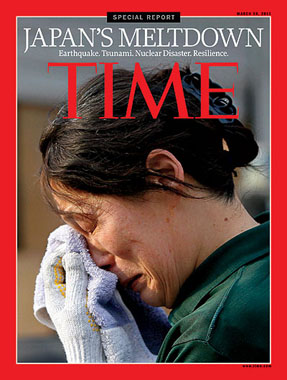
東日本を襲った前例のない巨大な複合災害・東日本大震災、それはマグニチュード9.0という日本の地震史上未曽有の激震で始まり、高さ15メートルにも達する巨大津波が押し寄せ、それらの自然災害が福島原子力の発電所を破壊して、日本人のみならず世界中の人々を放射能の恐怖に陥れた。
この災害とそれに苦しむ人々の表情を、世界中のメディが取材して発信している。
取材する人々が一様に驚いているのは、地震や津波のもたらした悲惨な状況は無論、それを受容している人々の表情だ。被災した人々は、どれほど強烈な打撃を蒙り、いかに深刻なストレスに見舞われているか、他人には想像もつかない。なのに彼らは、自分の蒙っている苦難と、それがもたらす悲しみとを、礼節を以て表現している。
こうした災害の場でありがちな、略奪や暴動といった事態は、全くと言ってよいほど報告されていない。中には無人になった宝石店を襲うなどの、不届きな事件も起きているが、そうした火事場泥棒的な動きは例外といってよい。少なくとも被災した人々が、相互に困らせあうようなことは、どこでも起きていない。
また福島の原子力発電所の事故に当たっては、原発職員や政府から派遣された人々が、危険な状況の中を、自分の命を懸けて働いている。
被災した人々が、利己的でないのと同様、こうした人々も利己的な心を全く感じさせない。
こんな日本人を、外国のジャーナリストたちは、礼節を弁え、かつ勇気ある人々だとたたえている。筆者もまた、同じ日本人として、こうした人々を、心から誇りに思う。
ここでは、TIMEの最新号が特集した記事の一端を引用しておこう。
The Day the Earth Moved By NANCY GIBBS Monday, Mar. 28, 2011
The 9.0 quake that hit Japan on March 11 was powerful enough to shift the earth on its axis and make it spin a little faster, shortening the day by 1.8 millionths of a second. It shoved the island nation one parking space to the east. But what felt like the end was just the beginning.
The sturdy buildings that survived the quake were ravaged by the wave that followed. The three-story wall of water dissolved coastal towns, dry-docked boats on the roofs of buildings and shuffled houses like playing cards. There were so many aftershocks that people stopped diving under tables. Those who made it safely to higher ground waited in the dark, in the cold, in lines that stretched for hours for water and food. In a society seen as the most stoic on earth, the closest thing to chaos was a man cutting in line.
But still it was not over; only the earth and sea had spoken. The next danger came from the sky. Officials warned people to stay inside and seal whatever was left of their homes because the new threat was silent, invisible -- and airborne. A rich country perched on four fault lines and with no oil reserves embraces nuclear power with the caution born of long memory and scars. But no one calculated what would happen if the fail-safes failed.
When the quake hit, the reactors at the Fukushima Daiichi complex did exactly what they were supposed to do: they shut down. But then the wave came, breached the seawall, drowned the backup generators needed to cool the reactors and took out the spare batteries. It was left to a skeleton crew of 50 to jury-rig fire hoses to keep the temperatures down.
One by one, the outer buildings exploded. This is also what they were designed to do, to release pressure and protect the core. The best nuclear scientists on the planet raced to avert a total meltdown even as radioactivity levels as far south as Tokyo spiked to 23 times as high as normal. With the menace growing by the hour, the most fateful calculation came down to the most fickle: Which way is the wind blowing?
It only started as a natural disaster; the next waves were all man-made, as money fled to higher ground. Fear and uncertainty sheared $700 billion off the Toyko Stock Exchange in three days. Japan makes nearly a quarter of the world's semiconductors and most of its gadgets. Sony suspended production at seven plants; carmakers slowed output, fearful of gaps in the supply chain; power companies scheduled rolling blackouts. How can a global recovery take hold if the world's third largest economy is out of business, even temporarily? Meanwhile, Switzerland announced a freeze on new nuclear plants, Germany shut down all its facilities built before 1980, and the U.S. Congress called for hearings on nuclear safety. The flooded Japanese plants will never reopen. But demand for power only grows.
We sleep easy in the soft arms of clichés: hope for the best, prepare for the worst; risk varies inversely with knowledge; it's a waste of time to think about the unthinkable. But Japan shook those soothing assumptions. No amount of planning, no skills or specs or spreadsheets, can stop a force that moves the planet.
関連記事:
横浜で大地震に遭遇す:東日本大震災の記録
東日本大震災
福島原発炉心溶融(Meltdown)を巡るプラウダ記事
困難を極める救出作業:東日本大震災
日本の原子力危機(Nuke Crisis)
福島の原発事故世界を揺るがす
見えない恐怖:放射性物質
政府無策の六日間:東日本大震災
遺体を運ぶ:東日本大震災
計画停電と交通マヒ:東日本大震災
欲ボケが国を滅ぼす?:東電福島原発事故

コメントする